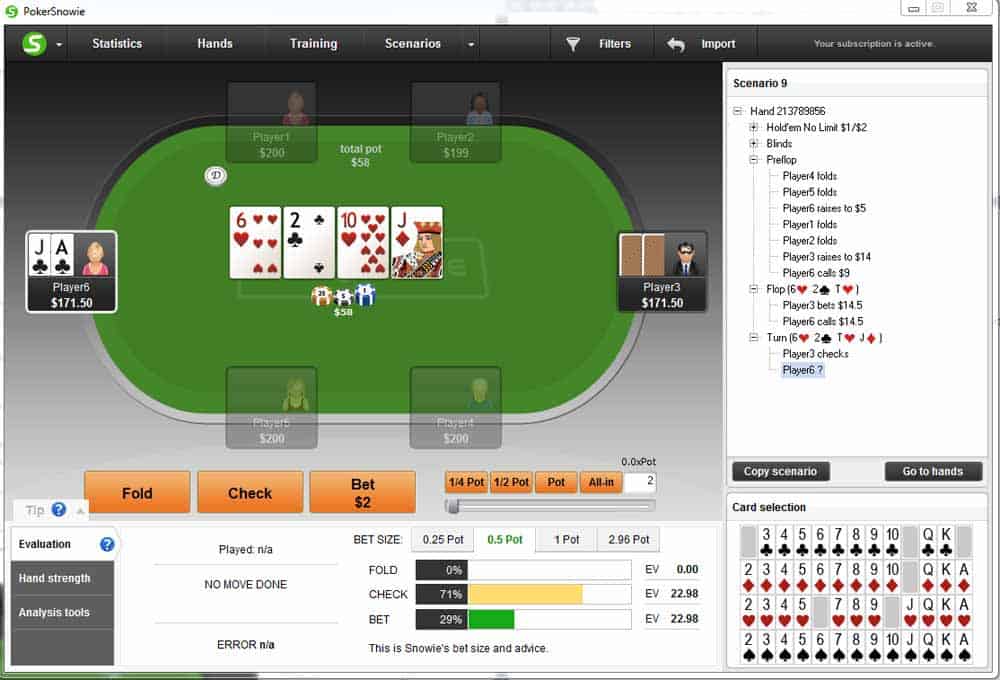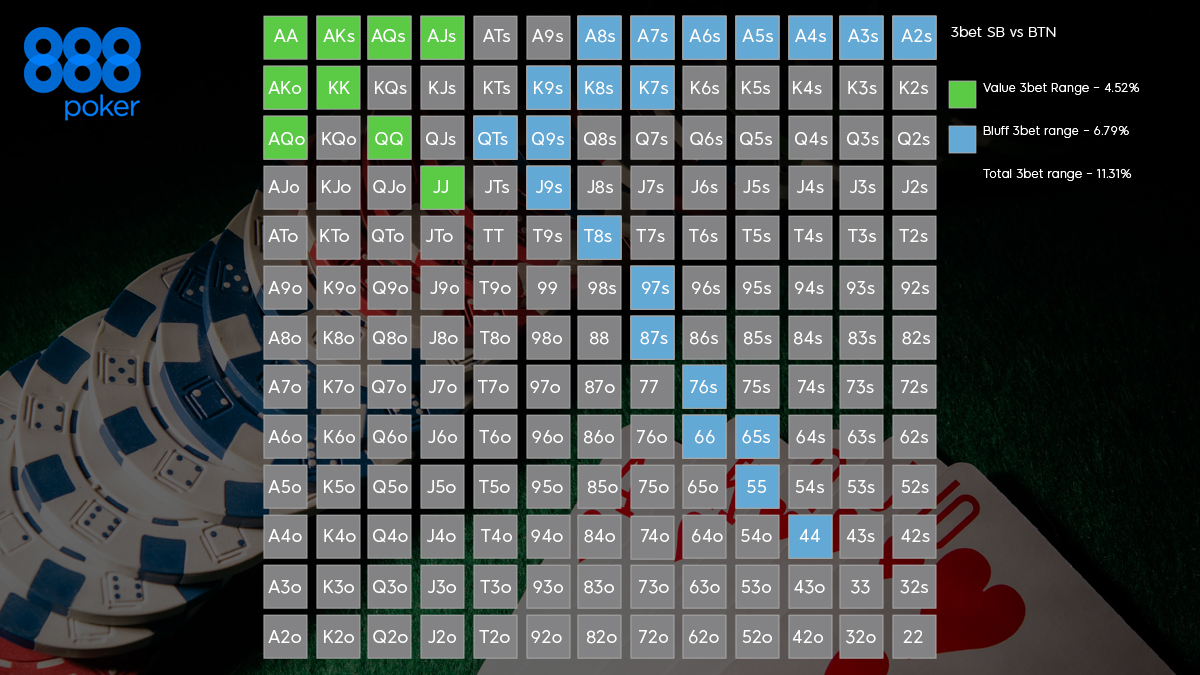Playing in 3-bet Pots: Win More With These Adjustments. Finding the right strategy to navigate 3-bet pots in Texas Hold'em is one of the key areas of your overall game-plan. By the nature of things, 3-bet pots are usually on the bigger side, which means they involve more variance. 3-betting hands like suited connectors preflop allows you to use them as bluffs on Ace and King high flops. RULE #18 Suited connectors suffer equity loss post-flop when the stack-to-pot ratio is smaller (1 to 3). That said, they tend to retain and even over-realize equity with medium (4-6) and deep (7+) stack-to-pot ratios.
In my newest book, The Course, I recommend playing very aggressively from the blinds if you are facing a potential steal raise. Whenever someone raises from the button or cutoff, and you suspect the player is raising with a wide range of hands to “play position,” you should attack. I suggest reraising with roughly 20 percent of all hands from the big blind in this situation.
Twenty percent is a lot of hands—far more than just pocket jacks or better and ace-king that many are used to reraising. My recommendations include reraising with hands like K-6 suited and A-2 suited and 3-3.
A lot of readers don’t know what to make of this advice. They like the idea of fighting back against loose, blind stealers. They don’t like the idea of playing those big pots holding K-6 suited once they get called. They especially don’t like the fact that they’ll be playing those pots out of position.
I’d admit that this can be a sticky situation if you are against a tough, top-level player. They will understand the dynamics of this situation well, and they will rarely make huge, consistently exploitable errors.
Fortunately, you likely won’t be playing against tough, top-level players. You’ll be playing against whoever happens to be in Seat 8. And, by and large, that player will play these pots in weak and predictable ways. A relatively formulaic approach will have you navigating these pots with ease.
There are a few basic principles at work.
Principle 1. Your opponent will always give you credit for a tighter, stronger range than you have.
As I said above, 20 percent of all hands is actually quite a lot of hands. Even if your opponent gets a whiff that you will three-bet “light” sometimes, nearly all players at the $1-$2 through $5-$10 levels will tend to give your three-bet too much credit on average. So when they call the three-bet, they typically will do so with a mindset that they are probably behind in the hand and have to hit the flop.
These players tend to be willing to release too easily when they don’t hit the flop.
Principle 2. Your opponent will always be scared that you have pocket aces, no matter how many times you make a weak play after the flop.
For a minute, let’s pretend you’re the person making the steal-raise and calling the three-bet. One player limps in a $2-$5 game with $1,000 stacks. You make it $25 to go with 8 7. The player in the big blind makes it $80. The limper folds, and you call the $55 more.
The flop comes J 7 6. The big blind bets $100, and you call. There’s $367 in the pot.
Pause a minute and consider what you would be thinking about in this situation.
The turn comes the 6. Your opponent checks, and you check it back.
The river is the 3. Your opponent now bets $400 into the $367 pot. What are you thinking now?


If you are like most people, you are worried your opponent has pocket aces. Or pocket kings or a set, but aces are likely to be concern number one.
Your fear of pocket aces persisted throughout the hand, despite the fact that your opponent checked the turn and could potentially have been planning to fold to a bet. The big river bet seems to “confirm” your fear. And, if you’re like most players at this level, you would likely fold your pair of sevens to the river bet.
Principle 3. Your opponents will therefore play very straightforwardly in these pots.
If you bet strongly, your opponents will give you credit for a strong range of hands. If you check or act weakly on the flop or the turn, your opponents will fear that you are trapping. Therefore, even though your opponents have position on you, they will tend to bet their big hands to prevent you from drawing out, they will check their medium hands to get to showdown, and they will refrain from trying big bluffs for fear you are trapping. They may fire once as a bluff to take a stab at the pot, but most players are unlikely to fire two or three barrels at you.

Obviously these principles don’t hold universally, and tougher players will violate them regularly. But if you find yourself out of position in a three-bet pot against a relatively unknown opponent, play to these principles until shown something different. Let’s go through a couple examples to see what it means to play to these principles.
It’s a $2-$5 game with $1,000 stacks. One player limps, and someone makes it $25 to go on the button. You’re in the big blind with A 3 and make it $80 to go. The limper folds, and the button calls after thinking briefly.
The flop comes A 9 7. Since your opponent is likely to give you credit for a strong hand, it’s unlikely you can get your opponent to call more than once with a hand you beat. So your job here is to get one bet into the pot by the river, while avoiding paying off more if your opponent has you beaten.
Poker 3 Bet Potion
You can start by checking. If your opponent bets, you can call and then try to check it down. If your opponent bets a second time, assume your hand is beaten and fold.
More often, when you check this flop, your opponent will check it back. Say a Q comes on the turn. You can bet or check. If you bet and get called, your plan is to check and fold the river. (Again, your opponent is unlikely to call the turn with a hand worse than yours and then try to bluff the river with it.) Or you can check again. If your opponent checks it back, you value bet the river. If your opponent bets the turn, you check and call, and then check and fold the river.
The idea here is that your opponent is likely to bet twice only with a hand that beats yours. So you can just check mostly and get one bet in at some point in the hand.
Now consider a second example. It’s the same action preflop, and you have the same hand—A 3. This time the flop comes 9 6 4. You bet $100, and your opponent calls. It’s a hard flop to hit, and your opponent may be in fit-or-fold mode and just fold a hand like K-Q or K-10.
The turn is the 3. You check, and your opponent checks it back.
Poker 3 Betting
The river is the K. You should probably make a big bluff—at least $300 into this $367 pot. Your opponent will be quick to give you credit for A-K or A-A and fold weaker hands.
Playing these three-bet pots from out of position is surprisingly easy against typical small-stakes opponents. They will tell you how strong they are by the river, and if they are weak, you can either take your hand to showdown or steal the pot. ♠
Poker 3 Bet Potential
Ed’s newest book, The Course: Serious Hold ‘Em Strategy For Smart Players is available now at his website edmillerpoker.com. You can also find original articles and instructional videos by Ed at the training site redchippoker.com.